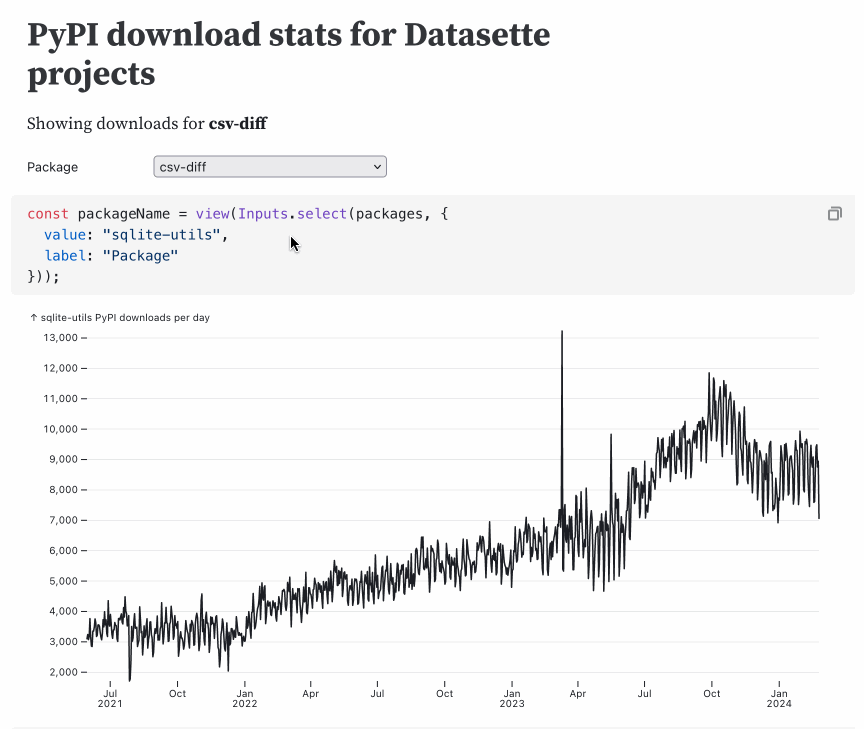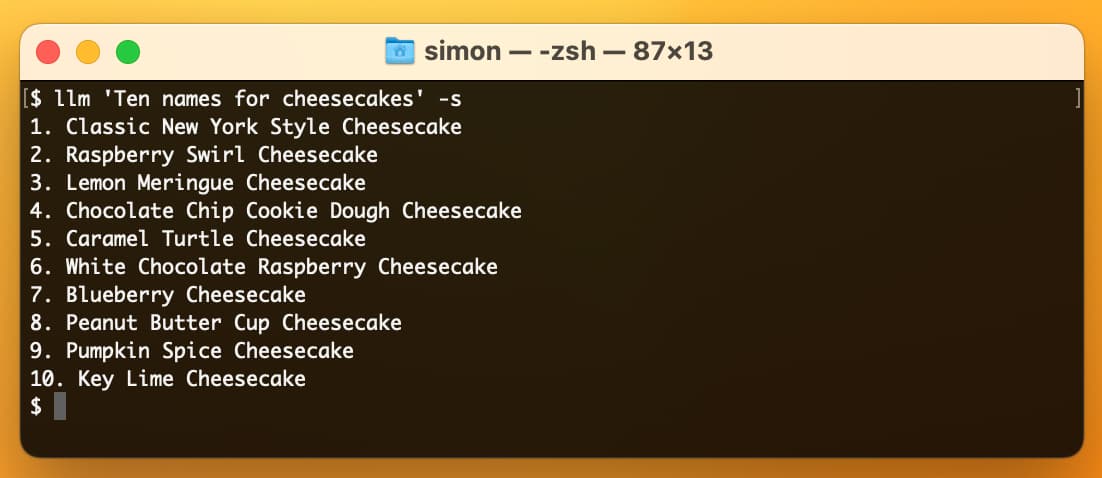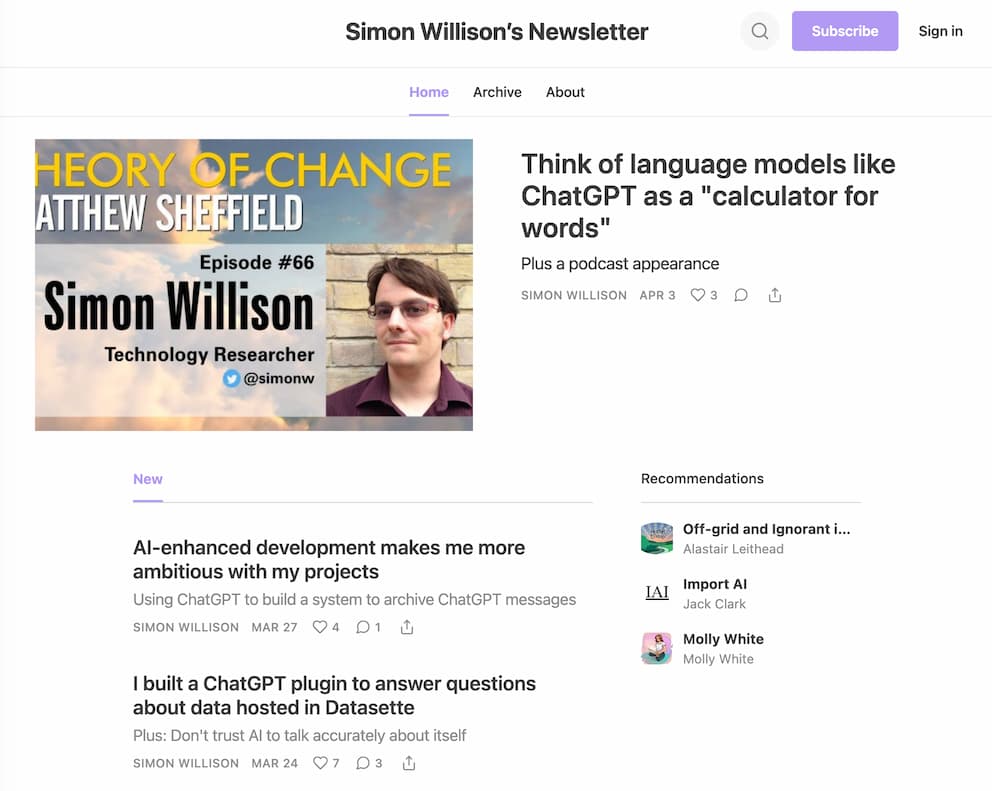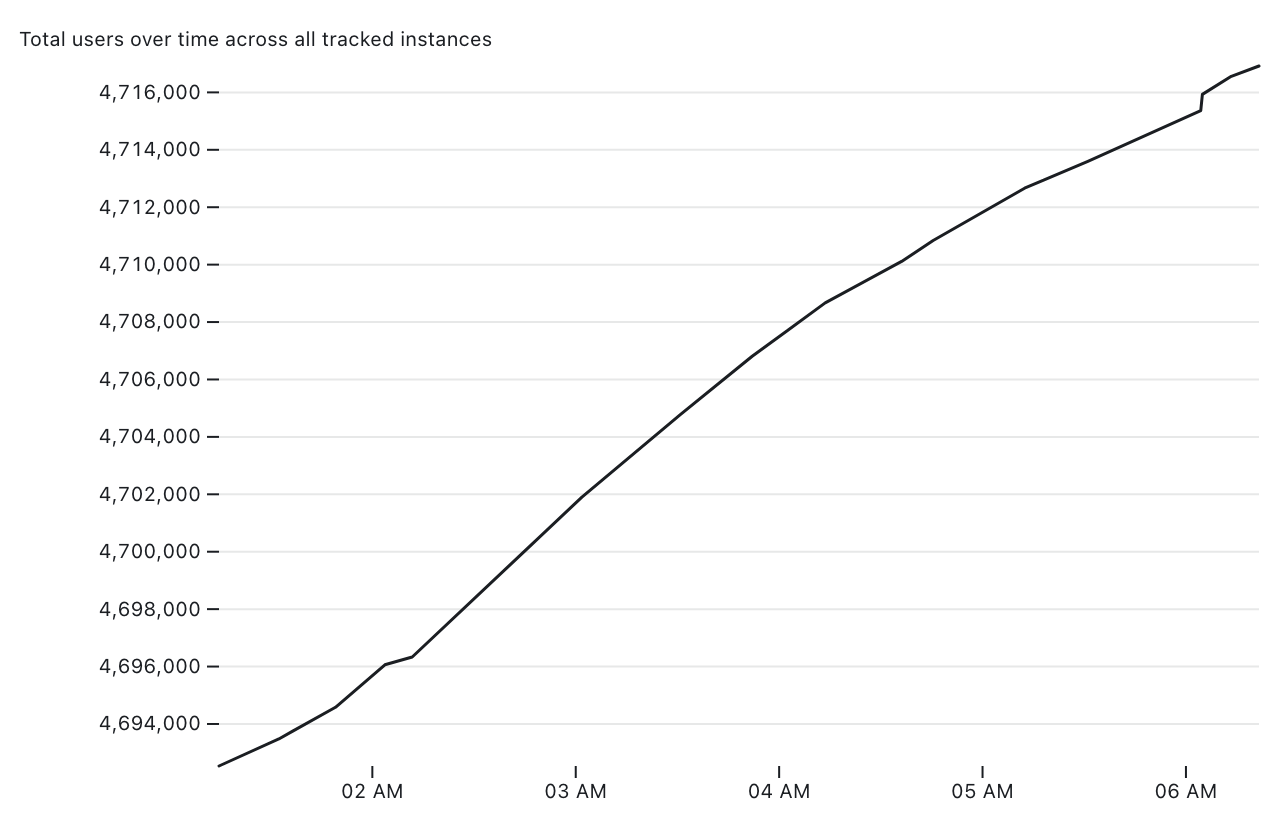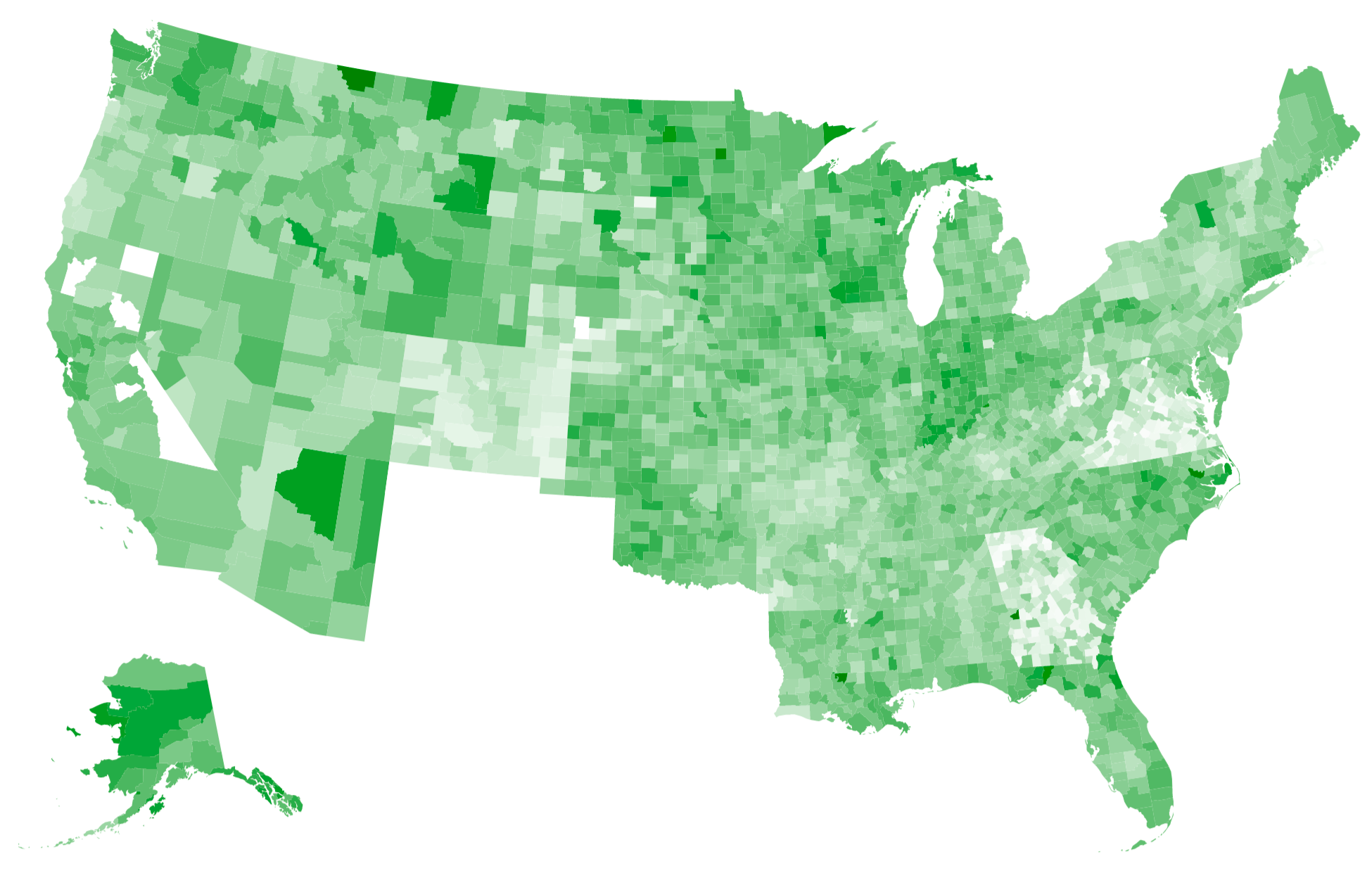45 items tagged “observable”
2024
Hacker News homepage with links to comments ordered by most recent first (via) Conversations on Hacker News are displayed as a tree, which can make it difficult to spot new comments added since the last time you viewed the thread.
There's a workaround for this using the Hacker News Algolia Search interface: search for story:STORYID, select "comments" and the result will be a list of comments sorted by most recent first.
I got fed up of doing this manually so I built a quick tool in an Observable Notebook that documents the hack, provides a UI for pasting in a Hacker News URL to get back that search interface link and also shows the most recent items on the homepage with links to their most recently added comments.
See also my How to read Hacker News threads with most recent comments first TIL from last year.
marimo.app. The Marimo reactive notebook (previously) - a Python notebook that's effectively a cross between Jupyter and Observable - now also has a version that runs entirely in your browser using WebAssembly and Pyodide. Here's the documentation.
Ham radio general exam question pool as JSON. I scraped a pass of my Ham radio general exam this morning. One of the tools I used to help me pass was a Datasette instance with all 429 questions from the official question pool. I've published that raw data as JSON on GitHub, which I converted from the official question pool document using an Observable notebook.
Relevant TIL: How I studied for my Ham radio general exam.
Wrap text at specified width. New Observable notebook. I built this with the help of Claude 3 Opus—it’s a text wrapping tool which lets you set the width and also lets you optionally add a four space indent.
The four space indent is handy for posting on forums such as Hacker News that treat a four space indent as a code block.
GitHub Public repo history tool (via) I built this Observable Notebook to run queries against the GH Archive (via ClickHouse) to try to answer questions about repository history—in particular, were they ever made public as opposed to private in the past.
It works by combining together PublicEvent event (moments when a private repo was made public) with the most recent PushEvent event for each of a user’s repositories.
Coroutines and web components (via) I like using generators in Python but I rarely knowingly use them in JavaScript—I’m probably most exposed to them by Observable, which uses then extensively under the hood as a mostly hidden implementation detail.
Laurent Renard here shows some absolutely ingenious tricks with them as a way of building stateful Web Components.
Observable Framework 1.1 (via) Less than three weeks after 1.0, the 1.1 release adds a whole lot of interesting new stuff. The signature feature is self-hosted npm imports: Framework 1.0 linked out to CDN hosted copies of libraries, but 1.1 fetches copies locally and then bundles that code with the deployed static site.
This works by using the acorn JavaScript parsing library to statically analyze the code and find all of the relevant imports.
Interesting ideas in Observable Framework
Mike Bostock, Announcing: Observable Framework:
[... 2,123 words]Observable notebook: URL to download a GitHub repository as a zip file (via) GitHub broke the “right click -> copy URL” feature on their Download ZIP button a few weeks ago. I’m still hoping they fix that, but in the meantime I built this Observable Notebook to generate ZIP URLs for any GitHub repo and any branch or commit hash.
Update 30th January 2024: GitHub have fixed the bug now, so right click -> Copy URL works again on that button.
Marimo (via) This is a really interesting new twist on Python notebooks.
The most powerful feature is that these notebooks are reactive: if you change the value or code in a cell (or change the value in an input widget) every other cell that depends on that value will update automatically. It’s the same pattern implemented by Observable JavaScript notebooks, but now it works for Python.
There are a bunch of other nice touches too. The notebook file format is a regular Python file, and those files can be run as “applications” in addition to being edited in the notebook interface. The interface is very nicely built, especially for such a young project—they even have GitHub Copilot integration for their CodeMirror cell editors.
2023
datasette-plot—a new Datasette Plugin for building data visualizations. I forgot to link to this here last week: Alex Garcia released the first version of datasette-plot, a brand new Datasette visualization plugin built on top of the Observable Plot charting library. We plan to use this as the new, updated alternative to my older datasette-vega plugin.
Observable notebook: Detect objects in images (via) I built an Observable notebook that uses Transformers.js and the Xenova/detra-resnet-50 model to detect objects in images, entirely running within your browser. You can select an image using a file picker and it will show you that image with bounding boxes and labels drawn around items within it. I have a demo image showing some pelicans flying ahead, but it works with any image you give it—all without uploading that image to a server.
Llama encoder and decoder. I forked my GPT tokenizer Observable notebook to create a similar tool for exploring the tokenization scheme used by the Llama family of LLMs, using the new llama-tokenizer-js JavaScript library.
GPT-3 token encoder and decoder. I built an Observable notebook with an interface to encode, decode and search through GPT-3 tokens, building on top of a notebook by EJ Fox and Ian Johnson.
Weeknotes: A new llm CLI tool, plus automating my weeknotes and newsletter
I started publishing weeknotes in 2019 partly as a way to hold myself accountable but mainly as a way to encourage myself to write more.
[... 830 words]Semi-automating a Substack newsletter with an Observable notebook
I recently started sending out a weekly-ish email newsletter consisting of content from my blog. I’ve mostly automated that, using an Observable Notebook to generate the HTML. Here’s how that system works.
[... 2,520 words]Introducing sqlite-vss: A SQLite Extension for Vector Search (via) This latest SQLite extension from Alex Garcia is possibly his best yet: it adds FAISS-powered vector similarity search directly to SQLite, enabling fast KNN similarity lookups against a virtual table that feels a lot like SQLite’s own built-in full text search feature. This write-up includes interactive demos using Datasette called from an Observable notebook, running similarity searches against an index of 200,000 news headlines and summaries in less than 50ms.
2022
Tracking Mastodon user numbers over time with a bucket of tricks
Mastodon is definitely having a moment. User growth is skyrocketing as more and more people migrate over from Twitter.
[... 1,534 words]Spevktator: OSINT analysis tool for VK. This is a really cool project that came out of a recent Bellingcat hackathon. Spevktator takes 67,000 posts from five popular Russian news channels on VK (a popular Russian social media platform) and makes them available in Datasette, along with automated translations to English, post sharing metrics and sentiment analysis scores. This README includes some detailed analysis of the data, plus a link to an Observable notebook that implements custom visualizations against queries run directly against the Datasette instance.
Open every CSV file in a GitHub repository in Datasette Lite (via) I built an Observable notebook that accepts a GitHub repository as input, scans it for CSV files and generates a link to open all of those CSV files in Datasette Lite.
Introducing sqlite-lines—a SQLite extension for reading files line-by-line (via) Alex Garcia wrote a brilliant C module for SQLIte which adds functions (and a table-valued function) for efficiently reading newline-delimited text into SQLite. When combined with SQLite’s built-in JSON features this means you can read a huge newline-delimited JSON file into SQLite in a streaming fashion so it doesn’t exhaust memory for a large file. Alex also compiled the extension to WebAssembly, and his post here is an Observable notebook post that lets you exercise the code directly.
Datasette table diagram using Mermaid (via) Mermaid is a DSL for generating diagrams from plain text, designed to be embedded in Markdown. GitHub just added support for Mermaid to their Markdown pipeline, which inspired me to try it out. Here’s an Observable Notebook I built which uses Mermaid to visualize the relationships between Datasette tables based on their foreign keys.
GitHub Burndown (via) Neat Observable notebook by Tom MacWright—give it a GitHub access token and the name of a repo and it pulls the details of every issue and plots a burndown chart over time, showing how long issues stay open for. The code is worth spending some time with—the way it fetches data from the paginated JSON API is a really great example of using generators with Observable, and the chart itself is a lovely clear example of Observable Plot.
Observable Plot Cheatsheets (via) Beautiful new set of cheatsheets by Mike Freeman for the Observable Plot charting library. This is really top notch documentation—the cheatsheets are available as printable PDFs but the real value here is in the interactive versions of them, which include Observable-powered sliders to tweak the different examples and copy out the resulting generated code.
2021
Datasette downloads per day (with Observable Plot) (via) I built an Observable notebook that imports PyPI package download data from datasette.io (itself scraped from pypistats.org using a scheduled GitHub Action) and plots it using Observable Plot. Datasette downloads from PyPI apparently jumped from ~800/day in May to ~4,000/day in July—would love to know why!
Plot & Vega-Lite. Useful documentation comparing the brand new Observable Plot to Vega-Lite, complete with examples of how to achieve the same thing in both libraries.
Observable Plot (via) This is huge: a brand new high-level JavaScript visualization library from Mike Bostock, the author of D3—partially inspired by Vega-Lite which I’ve used enthusiastically in the past. First impressions are that this is a big step forward for quickly building high-quality visualizations. It’s released under the ISC license which is “functionally equivalent to the BSD 2-Clause and MIT licenses”.
Render single selected county on a map (via) Another experiment at the intersection of Datasette and Observable notebooks. This one imports a full Datasette table (3,200 US counties) using streaming CSV and loads that into Observable’s new Search and Table filter widgets. Once you select a single county a second Datasette SQL query (this time retuning JSON) fetches a GeoJSON representation of that county which is then rendered as SVG using D3.
Animated choropleth of vaccinations by US county
Last week I mentioned that I’ve recently started scraping and storing the CDC’s per-county vaccination numbers in my cdc-vaccination-history GitHub repository. This week I used an Observable notebook and d3’s TopoJSON support to render those numbers on an animated choropleth map.
[... 1,138 words]2020
Datasette Client for Observable (via) Really elegant piece of code design from Alex Garcia: DatasetteClient is a client library he built designed to work in Observable notebooks, which uses JavaScript tagged template literals to allow SQL query results to be executed against a Datasette instance and displayed as inline tables in a notebook, or used to return JSON data for further processing. His example notebook includes a neat d3 stacked area chart example built against a Datasette of congresspeople, plus examples using interactive widgets to update the Notebook.
